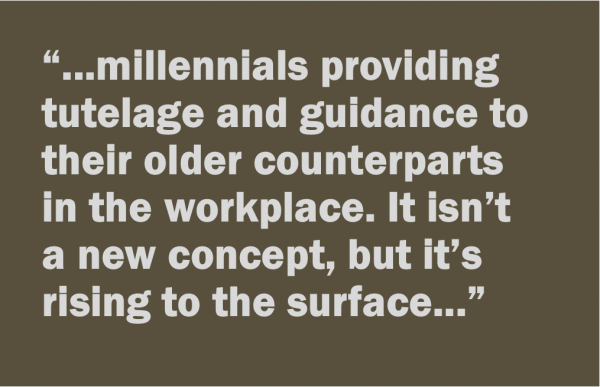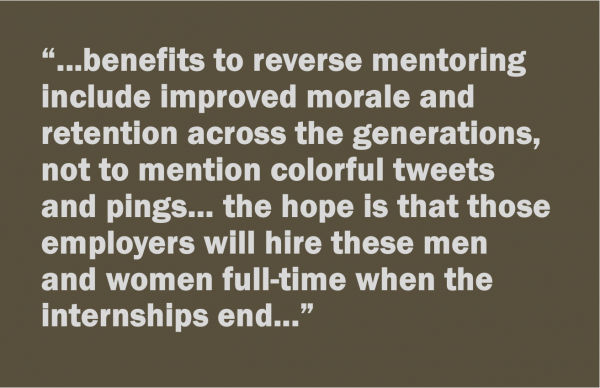PERSPECTIVE: Reverse Mentoring – The Answer for Connecticut’s Seasoned Workers?
/by Frances J. Trelease The idea first caught on a couple years ago, with the popularity of the movie “The Intern.” In that film, A-list actor Robert DeNiro plays a retired professional who accepts an internship with a trendy online fashion company, to sharpen his skills and stay engaged. By the end of the film -- as you might have guessed – DeNiro earns his stripes as a valued team player who is looked to for his temperance and wisdom when chaos erupts.
The hit film brought to light the concept of reverse mentoring – millennials providing tutelage and guidance to their older counterparts in the workplace. It isn’t a new concept, but it’s rising to the surface as retired or downsized professionals seek novel ways to reenter the workforce. It plays off the “traditional” apprenticeship model, where a young trainee learns a craft or trade under the watchful eye of an older, more experienced worker. 
Jack Welsh, former CEO of General Electric, is widely credited with introducing the concept to the U.S. in 1999, when he charged his top officials with finding junior mentors to teach them the latest technologies. He was on to something, those 17 years ago.
According to U.S. Census Bureau projections, “the proportion of Connecticut’s population that is 60 and older is growing more rapidly than other sectors of the population.” The Bureau estimates that nearly 26 percent of Connecticut’s population will be 60 and older by the year 2030.
So for Connecticut’s aging workers, reverse mentoring makes good sense. Many have been phased out of jobs before they felt ready to go. Others voluntarily retired, but still have much to offer. But they face a changing work environment.
The largest hiring blocks in CT in 2016 were hospitality, transportation, financial and business services. (www.cga.ct.gov) Those fields challenge the training and skill sets of those born in the “baby boomer years” – 1948 to 1964 -- who attended college or trade school before today’s digital and electronic gadgets – nay, even basic computer systems -- were ubiquitous. For them, today’s millennials hold the key to the knowledge and skills needed to succeed in fields like social media marketing and applications development.
The younger set, in turn, gains insight into strategy, negotiation skills and “macro”’ views of the big picture. They become groomed to step into leadership roles when their time comes.
Who wins from this emerging trend? Both groups do. Intellectual property continues to be the singles biggest asset of corporations across the U.S. In Connecticut alone, service giants such as United Technologies Corp., The Hartford, and Stamford-based Deloitte rely on the best and the brightest minds to innovate, create and outpace the competition. Those best and brightest range anywhere from 25 to 75 years old.
Lisa Bonner is director of Change Management & Communications at Cigna in Hartford. In a recent TEDx talk, she spoke of the value of the younger set sharing social media and mobile technology knowledge with Cigna’s “senior leaders.” Bonner described “putting a 25 year old in the chairman’s office” a “leap of faith… but I knew we were going on to glory. It was difficult to take that step, but we did it. Once they opened up with each other, that’s when the magic started to happen.” (https://youtu.be/uCd7_0BTySY)
Michelle Manson is a blog writer for Chronus, (Chronus.com), which creates software to help run corporate mentoring programs. Manson writes that organizations such a Hewlett Packard, Ogilvy and Mather and Cisco have signed on to the concept.
She writes: “When Hartford Insurance started a reverse mentoring program in 2011, the aim was to train C-suite execs in the tools and culture of social media. With entry-level employees in their twenties as mentors, the business leaders soon began to appreciate the power of ‘searching’ for answers on the spot and they wanted others in the company to benefit from the same flexibility. As a result, they unlocked social networks that were previously off-limits to Hartford employees.”
 Other benefits to reverse mentoring – improved morale and retention across the generations, not to mention colorful tweets and pings that fly across social media platforms and engage the consumer.
Other benefits to reverse mentoring – improved morale and retention across the generations, not to mention colorful tweets and pings that fly across social media platforms and engage the consumer.
In Connecticut, reverse mentoring addresses just the tip of the iceberg. There’s so much more to be done. Initiatives such as the Platform to Employment in Bridgeport provide subsidies of $6,000 to qualifying employers if they bring on unemployed – often senior -- people for eight-week training internships. The hope is that those employers will hire these men and women full-time when the internships end.
And Boomer Den, LLC of Oxford, CT works exclusively with adults ages 45 and older, to fit them to internships, temp-to-hire and permanent positions around the state. In many cases, candidates show up to work ready to learn from those a generation or two younger.
Independent forecasters estimate that half our U.S. workforce will be made up by workers born in the mid-1980s or later. It’s time in Connecticut to bridge generational gaps. It’s time we take a step back – and then a solid leap forward, toward pooling our talents for mutual gain.
_________________________
Frances J. Trelease is president of Boomer Den, LLC, a Connecticut agency that empowers adult workers through internships and job placement opportunities. She may be contacted at info@boomerden.com.
PERSPECTIVE commentaries by contributing writers appear each Sunday on Connecticut by the Numbers.





























